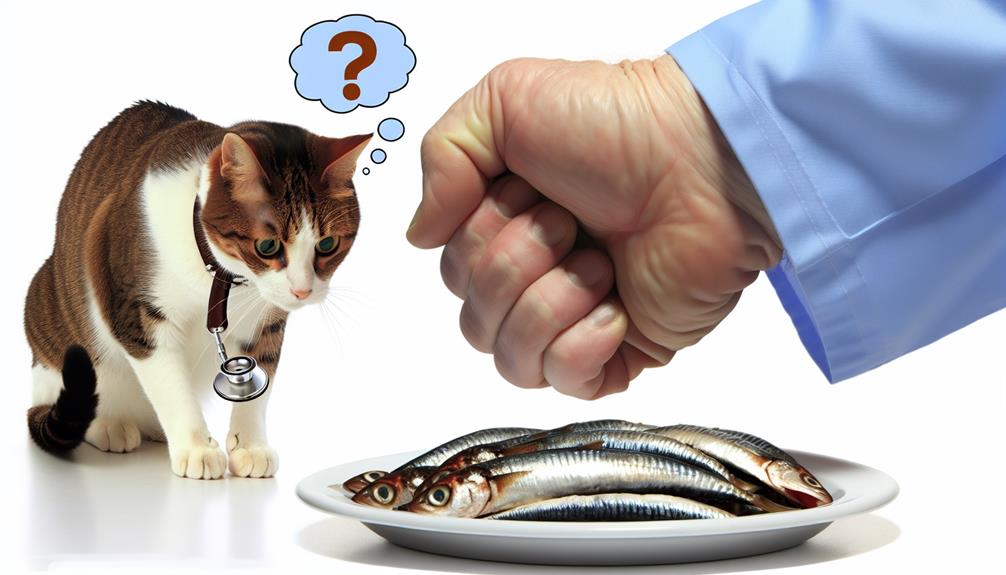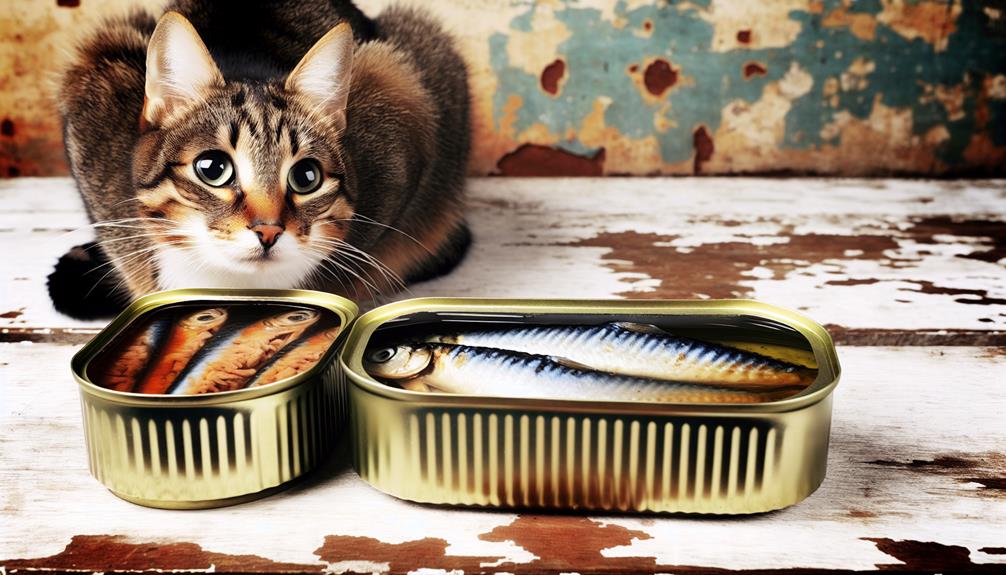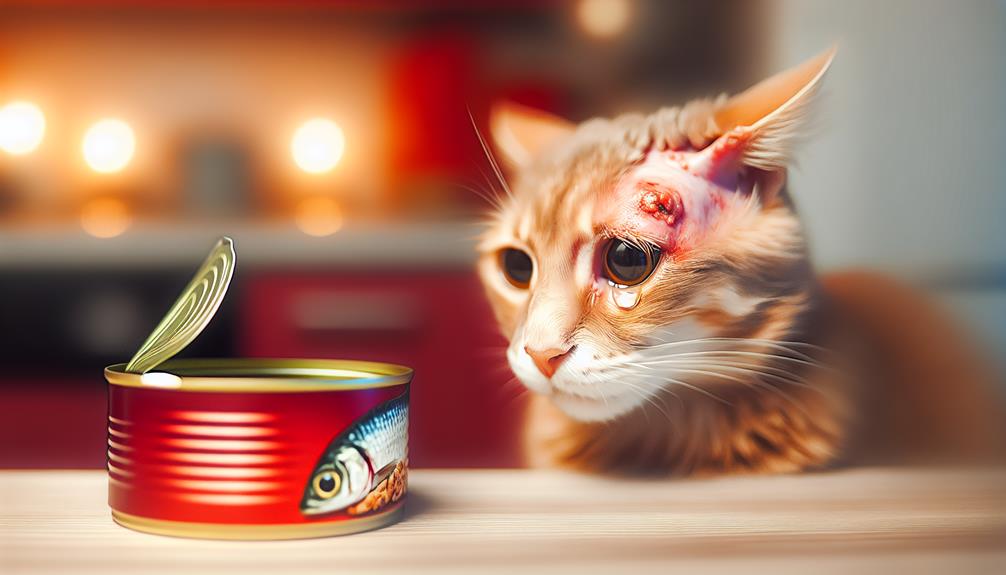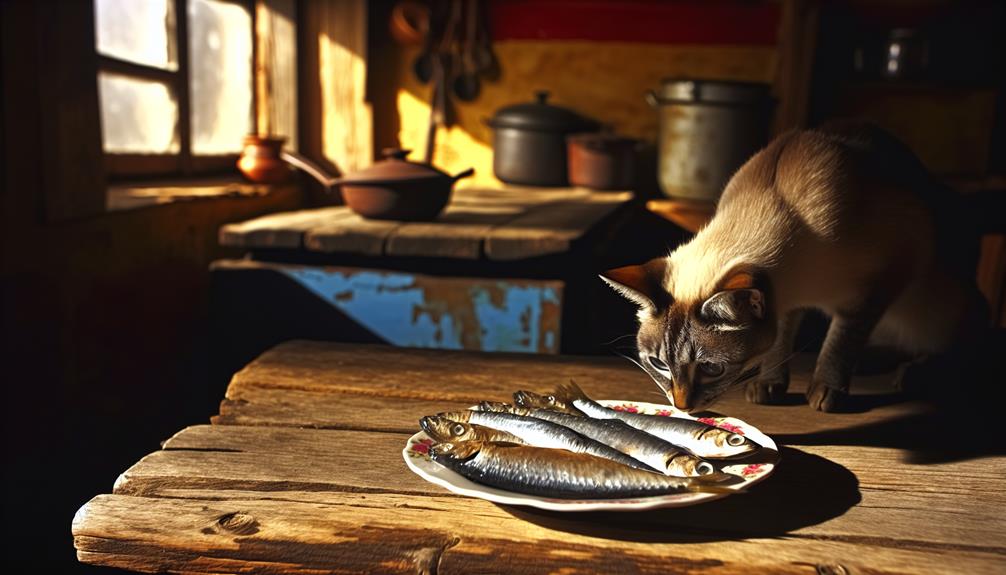Have you ever wondered if your cat can enjoy sardines as a treat? These small fish are packed with beneficial nutrients like protein and omega-3 fatty acids, which can support your cat's overall health and give them a shiny coat. But before you open a can, there are some essential considerations, such as the type of sardines and the portion size. It's important to choose wisely and serve in moderation. Curious about the best way to share sardines with your feline friend and avoid potential health risks? Let's explore the details further.
Nutritional Value
When considering the nutritional value of sardines for cats, it's important to recognize that these small fish are rich in essential nutrients. Sardines provide a high-quality source of protein, essential for maintaining your cat's muscle mass and overall health. They are also abundant in omega-3 fatty acids, which contribute to healthy skin and a shiny coat.
Proper sardine preparation is important for ensuring your cat's safety and best nutrition. You should always choose sardines packed in water without added salt or harmful preservatives. Cats can be sensitive to high sodium levels, so it's best to avoid sardines that come in brine, oil, or flavored sauces. Additionally, always inspect the sardines for bones, as small bones can pose a choking hazard or cause internal injuries.
Cat preferences play a significant role when introducing sardines into their diet. Some cats may be immediately attracted to the strong smell and taste, while others might be hesitant. Begin by offering a small portion to gauge your cat's reaction. If your cat shows interest, you can gradually incorporate sardines into their diet, either as a treat or mixed with their regular food.
It's worth noting that sardines should not replace a balanced, complete cat food but can be used to supplement your cat's diet. Moderation is key, as overfeeding sardines can lead to an imbalance of nutrients. By carefully preparing sardines and paying attention to your cat's preferences, you can enhance their diet with this nutrient-rich fish, ensuring they receive the maximum benefits while maintaining overall health.
Health Benefits
When considering the health benefits of sardines for your cat, you'll find that this nutrient-rich fish is an excellent source of essential omega-3 fatty acids. These fatty acids play a vital role in reducing inflammation and supporting cardiovascular health. Additionally, the high protein content in sardines contributes to maintaining muscle mass and overall physical health in felines.
Nutrient-Rich Fish Source
Sardines, rich in essential nutrients, offer numerous health benefits for cats, making them an excellent addition to their diet. When considering sardine preparation, it's important to choose options that align with your cat's preferences and nutritional needs. Sardines are packed with essential elements such as protein, vitamins, and minerals, contributing greatly to your cat's overall health.
Key Nutrients in Sardines:
- Protein: Essential for muscle repair, growth, and overall maintenance, sardines provide a high-quality protein source that supports your cat's active lifestyle.
- Vitamin B12: This vitamin is important for maintaining nerve function and producing red blood cells. A deficiency in Vitamin B12 can lead to anemia and neurological issues in cats.
- Calcium and Phosphorus: These minerals are crucial for bone health and dental integrity. Ensuring your cat receives an adequate supply can prevent issues like osteoporosis and dental decay.
When preparing sardines, consider your cat's preferences for texture and flavor. Opt for fresh or water-packed sardines without added salt or seasoning, as these additives can be harmful. By incorporating nutrient-rich sardines into your cat's diet, you'll be promoting a healthier, more vibrant life for your feline companion.
Omega-3 Fatty Acids
Omega-3 fatty acids, a vital component found in sardines, offer considerable health benefits for cats. These essential fatty acids are mainly sourced from marine life, making sardines an excellent omega-3 source. When incorporated into your cat's diet, omega-3 fatty acids can greatly improve various physiological functions.
One of the primary sardine benefits is enhanced cardiovascular health. Omega-3 fatty acids, especially EPA (eicosapentaenoic acid) and DHA (docosahexaenoic acid), play a fundamental role in reducing inflammation, which can help mitigate heart disease risks. Additionally, these fatty acids support cognitive function, potentially aiding in the prevention of neurodegenerative diseases and improving brain health.
Furthermore, omega-3 fatty acids contribute to a robust immune system. By modulating inflammatory responses, they help your cat's body combat infections and chronic conditions more effectively. Omega-3 fatty acids are also known for their dermatological benefits, promoting a healthier coat and skin by reducing dryness and flakiness.
Protein for Muscle Health
Incorporating high-quality protein into your cat's diet is fundamental for maintaining ideal muscle health. Sardines are a fantastic source of protein, which plays a significant role in muscle recovery and overall well-being. Making certain your cat receives adequate protein can lead to several health benefits, particularly regarding muscle maintenance and development.
Here are three key benefits of protein for your cat's muscle health:
- Muscle Recovery: After any physical activity or even daily movement, your cat's muscles undergo wear and tear. Protein aids in the repair and growth of muscle tissues, which is crucial for muscle recovery and maintaining strength.
- Protein Absorption: The bioavailability of protein in sardines guarantees that your cat's body efficiently absorbs and utilizes these nutrients. Efficient protein absorption supports ideal muscle function and overall physical health.
- Lean Muscle Mass: High-quality protein from sardines helps in preserving lean muscle mass, which is particularly important as cats age. Maintaining lean muscle mass can contribute to better mobility and reduced risk of muscle-related ailments.
Potential Risks

When considering feeding sardines to your cat, you should be aware of potential risks such as high mercury levels, which can cause neurological damage over time. Additionally, the elevated sodium content in sardines could lead to hypertension or kidney issues, especially in cats with pre-existing conditions. Finally, some cats may exhibit digestive system sensitivity, resulting in gastrointestinal upset or diarrhea.
High Mercury Levels
High mercury levels in sardines can pose significant health risks to cats. Mercury exposure in felines can lead to a variety of medical issues, especially when sardines are a frequent part of their diet. Elevated mercury levels can affect the nervous system, kidneys, and cardiovascular health of your cat.
To better understand the potential risks, consider these points:
- Neurological Damage: Chronic mercury exposure can cause tremors, coordination issues, and cognitive dysfunction in cats, affecting their overall quality of life.
- Renal Problems: The kidneys filter toxins from a cat's blood, and high mercury levels can impair this function, potentially leading to renal failure.
- Cardiovascular Stress: Mercury can accumulate in the heart tissue, causing arrhythmias or other cardiovascular anomalies that can be life-threatening.
Given these risks, it's important to explore safe alternatives when considering sardines as a treat for your feline friend. Opt for low-mercury fish like salmon or trout, which are less likely to cause mercury toxicity. Additionally, ensuring your cat's diet is balanced and primarily composed of cat-specific commercial foods will help mitigate these risks. Always consult with a veterinarian before introducing new foods to your cat's diet.
Sodium Content Concerns
Maintaining a low-sodium diet for your cat is vital for their overall health, as excessive sodium intake can lead to various medical complications. Cats have a limited ability to excrete sodium through their kidneys, making them particularly susceptible to hypernatremia, a condition characterized by elevated sodium levels in the blood. The sodium impact on your cat's cardiovascular and renal systems can be severe, potentially leading to hypertension, kidney damage, and even heart failure.
When considering sardines as a treat for your feline friend, it's important to be mindful of the sodium content. Sardines, especially those canned in brine or oil, often contain high levels of sodium, which can be detrimental to your cat's health if consumed frequently. Dietary moderation is key; offering sardines sparingly can help mitigate the risks associated with excessive sodium intake.
To guarantee that your cat's sodium levels remain within a safe range, opt for sardines labeled as low-sodium or those packed in water without added salt. Always consult your veterinarian for personalized dietary advice tailored to your cat's specific health needs. Taking these precautions will help maintain your cat's well-being and prevent sodium-related health issues.
Digestive System Sensitivity
Cats' digestive systems are particularly sensitive, and introducing new foods like sardines can pose potential risks. When you add sardines to your cat's diet, their digestive enzymes may not be adequately prepared to break down the new proteins and fats. This can lead to gastrointestinal disturbances.
- Disruption of Gut Flora: Sardines can alter the natural balance of gut flora, the beneficial bacteria vital for digestion. An imbalance can lead to diarrhea or constipation.
- Pancreatitis Risk: High-fat foods like sardines can overburden the pancreas, leading to pancreatitis, an inflammation that can be quite painful and dangerous for your cat.
- Allergic Reactions: Introducing sardines can trigger food allergies. Symptoms may include vomiting, diarrhea, or skin irritations.
It's essential to initially introduce sardines in minimal quantities and monitor your cat's response. If you observe any adverse reactions, consult with a veterinarian immediately. Also, consider the long-term effects on your cat's digestive enzymes and gut flora before making sardines a regular part of their diet. Ensuring a balanced diet will help maintain overall digestive health and prevent potential complications.
Serving Suggestions
When considering the best ways to serve sardines to your feline companion, it is essential to balance palatability with nutritional benefits. Cats are obligate carnivores, meaning their diet must consist primarily of meat. Consequently, sardines can be a nutritious supplement, but the method of preparation and presentation is paramount.
Firstly, let's explore some ideal cooking methods. Serving sardines raw is generally not recommended due to potential bacterial contamination and parasites. Instead, opt for steaming or boiling. These methods preserve the sardines' nutritional integrity while eliminating harmful pathogens. Avoid frying or grilling, as these techniques can introduce excessive fats and carcinogens that are detrimental to your cat's health.
Flavor combinations are another significant consideration. Cats are highly sensitive to taste and smell, so integrating sardines into their diet should be done cautiously. Mixing sardines with other cat-friendly foods like cooked chicken or rice can enhance the flavor profile without overwhelming their palate. However, refrain from adding spices or seasonings, especially garlic and onion, as these are toxic to cats.
Portion control is also important. Sardines should be offered as an occasional treat rather than a staple, due to their high mercury content. A small portion, approximately one sardine per week, can provide ample omega-3 fatty acids and protein without posing health risks.
Lastly, always verify that the sardines are deboned. Fish bones can be a choking hazard and may cause gastrointestinal perforation. By adhering to these serving suggestions, you can safely incorporate sardines into your cat's diet, leveraging their nutritional benefits while minimizing potential health risks.
Sardines in Oil Vs. Water

One vital decision when introducing sardines to your cat's diet is the choice between sardines in oil versus those in water. Both options have their merits, but understanding the differences can help you make an informed choice for your feline friend.
Sardines in oil are often more flavorful, which might appeal to your cat's flavor preferences. However, the oil, typically olive or soybean, adds extra calories and fat. While some healthy fats are beneficial, excessive fat intake can lead to obesity and related health issues. Additionally, some oils can cause gastrointestinal upset in cats, leading to diarrhea or vomiting.
On the other hand, sardines in water are generally a safer option. Here's why:
- Lower Caloric Content: Sardines in water have fewer calories, which is essential for maintaining your cat's ideal weight and preventing obesity-related conditions.
- Minimized Risk of Gastrointestinal Issues: Water-packed sardines are less likely to cause gastrointestinal disturbances, making them a more digestible choice.
- Reduced Sodium Levels: Often, sardines in oil contain added salt. High sodium levels can lead to hypertension and other cardiovascular issues in cats.
When considering sardine preparation, be mindful of the additives. Opt for plain, unsalted sardines without any additional flavorings or preservatives. Always read the label to verify that the product is suitable for feline consumption.
Ultimately, your cat's health should guide your decision. While sardines in oil might cater to flavor preferences, the health benefits of sardines in water make them a superior choice. Consulting your veterinarian can provide personalized advice tailored to your cat's specific dietary needs.
Frequency and Portion Size
While selecting between sardines in oil and water is important, determining the appropriate frequency and portion size is equally critical for your cat's health. Feeding frequency and portion guidelines are essential to guarantee your feline friend benefits from the nutritional advantages of sardines without adverse effects.
First, let's address feeding frequency. Sardines, although nutritious, should not be a daily diet staple for your cat. Overconsumption can lead to mercury accumulation and other health issues. A prudent approach is to offer sardines no more than once or twice a week. This moderation helps maintain a balanced diet while providing the benefits of omega-3 fatty acids and proteins found in sardines.
Next, we consider portion guidelines. Cats have varying dietary needs based on their size, weight, and activity level. Here's a simple table to help you determine the appropriate portion size:
| Cat Weight (lbs) | Portion Size (oz) |
|---|---|
| Under 10 | 0.5 – 1 oz |
| 10 – 15 | 1 – 1.5 oz |
| Over 15 | 1.5 – 2 oz |
This table provides a visual representation to help you gauge the appropriate serving size for your cat. Always start with the lower end of the range and observe your cat's reaction. Smaller portions minimize the risk of digestive upset or other adverse reactions.
Incorporating these feeding frequency and portion guidelines guarantees that your cat enjoys the health benefits of sardines without compromising their overall well-being. Adhering to these recommendations will help you strike the right balance, fostering a healthy and happy feline companion.
Signs of Allergies

Your cat's reaction to sardines can vary, and it is vital to watch for signs of allergies. Cats, like humans, can develop food allergies, and sardines might trigger such reactions. Recognizing the signs early guarantees your feline friend's well-being and prevents further complications. Here are some key indicators to monitor:
- Itchy Skin: One of the primary manifestations of an allergic reaction in cats is pruritus, or itchy skin. You may notice your cat excessively scratching, licking, or biting their skin. In severe cases, this can lead to hair loss, scabs, or open wounds due to persistent scratching. Pay attention to areas like the face, ears, and paws, as these are common sites for allergic reactions.
- Gastrointestinal Upset: Allergies to sardines can also manifest through gastrointestinal symptoms. If your cat experiences vomiting, diarrhea, or excessive flatulence after consuming sardines, this could indicate an intolerance or allergy. Additionally, your cat might exhibit signs of abdominal discomfort, such as bloating or a reluctance to be touched around the stomach.
- Respiratory Symptoms: Though less common, some cats may develop respiratory issues due to food allergies. Symptoms can include coughing, wheezing, or difficulty breathing. These symptoms necessitate immediate veterinary attention, as they can be indicative of a more severe allergic reaction.
If you observe any of these symptoms, it is important to consult your veterinarian. They may recommend an elimination diet to identify the allergen or perform tests to confirm the diagnosis. Prompt intervention can alleviate your cat's discomfort and prevent long-term health issues. Always prioritize your cat's health by monitoring their reactions to new foods like sardines.
Conclusion
Imagine your cat as a finely tuned sports car; sardines are like premium fuel, enhancing performance and shine. Packed with essential nutrients, they contribute to overall health but must be served wisely. Opt for water-packed sardines, limit to one a week, and always observe for adverse reactions. Just as you'd consult a mechanic for your car, seek your vet's advice to tailor your cat's diet, ensuring it purrs with peak health and liveliness.
